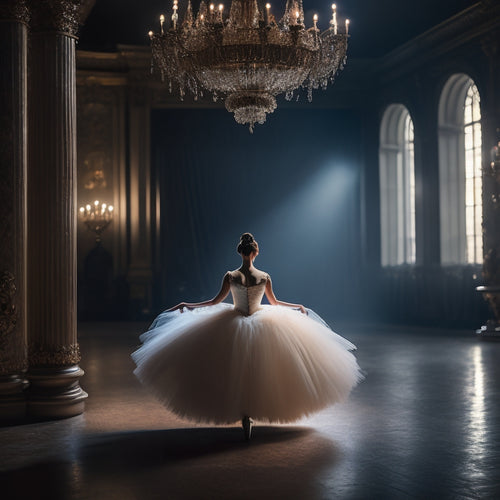
5 Tips for Choosing Arabic Music for Dance
Share
When selecting Arabic music for dance, you'll want to take into account the complexities of rhythm and time signatures, embracing the polyrhythmic patterns and identifying the primary rhythmic cycle. Explore various genres, from classical Maqam to modern fusion, and recognize the emotional resonance each brings. Pay attention to the instruments used, as they evoke distinct moods and energies. Curate a playlist that balances contrasting moods and intensities, and prioritize cultural authenticity in your music choice, costume, and choreography. By doing so, you'll be well on your way to crafting an engaging performance that respects and celebrates Arabic heritage - and there's more to discover.
Key Takeaways
• Focus on the primary rhythmic cycle in Arabic music, considering polyrhythmic patterns and time signatures to create a cohesive dance performance.
• Choose music from various Arabic genres, such as classical Maqam or modern Regional fusion, to evoke unique energies and emotional resonance for dance.
• Select instruments that evoke the desired mood and energy, like the intimate oud or dynamic qraqeb, to shape the emotional landscape of your dance.
• Curate a playlist that balances contrasting moods and intensities, selecting tracks that evoke emotions and memories for a dynamic performance.
• Prioritize cultural authenticity, respecting Arabic heritage in music, costumes, and choreography, and consult with experts to ensure accuracy and respect.
Understanding Rhythm and Time Signatures
When exploring Arabic music for dance, you'll frequently encounter complex rhythms and time signatures that demand a deep understanding to truly master. As a dancer, it's crucial to develop a strong foundation in rhythm and timing to execute movements confidently and safely.
Arabic music often features polyrhythmic patterns, where multiple rhythms are played simultaneously, creating a rich and intricate sound. To navigate these complex rhythms, focus on identifying the primary rhythmic cycle, which serves as the foundation for the music.
Within these rhythmic cycles, you'll find various time signatures, such as 4/4, 3/4, or 8/8, which dictate the pulse and meter of the music. As you practice, pay attention to the way the rhythms interact and overlap, creating a dynamic and engaging sound.
Exploring Arabic Music Genres
As you explore the world of Arabic music, you'll uncover a rich tapestry of genres, each with its unique characteristics, emotional resonance, and dance inspirations. From the classical Maqam evolution to modern Regional fusion, Arabic music genres offer a diverse range of styles to choose from.
The Golden age of Arabic music, which spanned from the 8th to the 13th century, laid the foundation for many of these genres. You'll find that Folklore roots run deep in Arabic music, with many genres drawing inspiration from traditional folk songs and stories. Instrumental storytelling is also a key element, with instruments like the oud and qraqeb often taking center stage.
As you explore further into the world of Arabic music, you'll discover that each genre has its own unique energy and emotional resonance, making some more suitable for high-energy dance routines, while others are better suited for more introspective performances. By understanding the characteristics of each genre, you'll be better equipped to choose the perfect music for your dance.
Identifying Instruments and Moods
You'll notice that the instruments used in Arabic music greatly influence the mood and energy of a song, with certain instruments evoking specific emotions and atmospheres that can elevate or transform your dance performance. The oud, for instance, typically evokes a sense of intimacy and sensuality, while the qraqeb's metallic timbre can add a dynamic, percussive energy to a piece. Understanding the emotional connotations of each instrument can help you choose music that complements your dance style and connects with your audience.
As you explore Arabic music, pay attention to the instrumental timbres and how they shape the emotional landscapes of each song. Notice how the ney's haunting tones can evoke a sense of longing, or how the riq's crisp rhythms can create a sense of urgency. By recognizing the emotional resonance of each instrument, you can craft a set list that takes your audience on a journey of emotions, from the subtle to the dramatic.
Selecting Music for Emotional Connection
To forge a deeper emotional connection with your audience, curate a playlist that strategically balances contrasting moods and intensities, allowing your dance to ebb and flow like a narrative. This approach will keep your audience engaged and invested in your performance.
To create a playlist that resonates with your audience, consider the following tips:
-
Tap into personal resonance: Choose songs that evoke emotions and memories for you, as this authenticity will translate to your audience.
-
Identify emotional triggers: Select songs that elicit strong emotions, such as joy, sadness, or excitement, to create a dynamic performance.
-
Balance intensity and calm: Alternate between high-energy and mellow tracks to keep your audience on an emotional rollercoaster.
- Consider the story you want to tell: Curate your playlist to convey a narrative or theme, using music to convey emotions and ideas.
Ensuring Cultural Authenticity Matters
When selecting Arabic music for your dance, it's important to prioritize cultural authenticity to avoid cultural appropriation and guarantee that your performance is respectful and meaningful. You want to make sure that your dance honors the rich cultural heritage of the Middle East, rather than reducing it to a shallow stereotype.
To achieve cultural sensitivity and artistic integrity, consider the following guidelines:
| Aspect | Culturally Sensitive Choice | Culturally Insensitive Choice |
|---|---|---|
| Music selection | Choose traditional Arabic music or modern interpretations that respect cultural roots. | Select music with stereotypes or inaccurate representations of Arabic culture. |
| Costume design | Incorporate traditional attire or inspired designs that pay homage to Arabic heritage. | Wear costumes that perpetuate negative stereotypes or appropriate cultural symbols. |
| Choreography | Create movements that respectfully incorporate traditional Arabic dance styles. | Use dance moves that mock or disrespect Arabic cultural traditions. |
| Lyrics and vocals | Use lyrics that celebrate Arabic culture and are sung by Arabic artists. | Use lyrics that perpetuate stereotypes or are sung by non-Arabic artists without cultural understanding. |
| Cultural consultation | Consult with Arabic cultural experts or artists to ensure accuracy and respect. | Ignore cultural nuances and forge ahead without consultation or understanding. |
Frequently Asked Questions
Can I Use Arabic Music With Explicit Lyrics for My Dance Performance?
'When choosing Arabic music for your dance performance, you should avoid songs with explicit lyrics, respecting Lyric Standards and Cultural Sensitivity; instead, opt for clean, family-friendly tracks that guarantee a safe and enjoyable experience for your audience.'
How Do I Obtain Necessary Licenses to Use Arabic Music in My Performances?
To legally use Arabic music in your performances, you'll need to obtain necessary licenses by clearing music rights through organizations like ASCAP or BMI, ensuring you comply with copyright laws, performance rights, and royalty fees to avoid legal issues.
Are There Any Arabic Music Composers Who Specifically Create Music for Dance?
You're wondering if there are Arabic music composers who craft tracks specifically for dance? Yes, you'll find music producers like Fadel Chakar and Ahmed El-Saedi, known for dance collaborations, creating beats that'll get your audience moving!
Can I Mix Arabic Music With Other Cultural Music Styles in My Dance?
You can absolutely mix Arabic music with other cultural styles in your dance, creating fusion beats that blend rhythmic traditions. Embrace cultural exchange and genre-bending experimentation, crafting a unique musical blend that's all your own.
Are There Any Arabic Music Playlists Available for Belly Dance Inspiration?
You can easily find Arabic music playlists online for belly dance inspiration, and music discovery platforms offer curated playlists for Middle Eastern and North African music, making playlist curation a breeze for you!
Related Posts
-

Dance Bags for Every Style and Budget
You need a dance bag that mirrors your unique style while staying within your budget, and there's plenty to choose fr...
-

Stellar Gifts for Creative Minds and Stargazers
Celestial-inspired gifts and creative tools can reveal the full potential of stargazers and imaginative minds, provid...
-

Unveiling Ballet: Insider Insights on Dance World
Ballet, an art form esteemed for its elegance and beauty, conceals a world of rigorous dedication, meticulous plannin...


